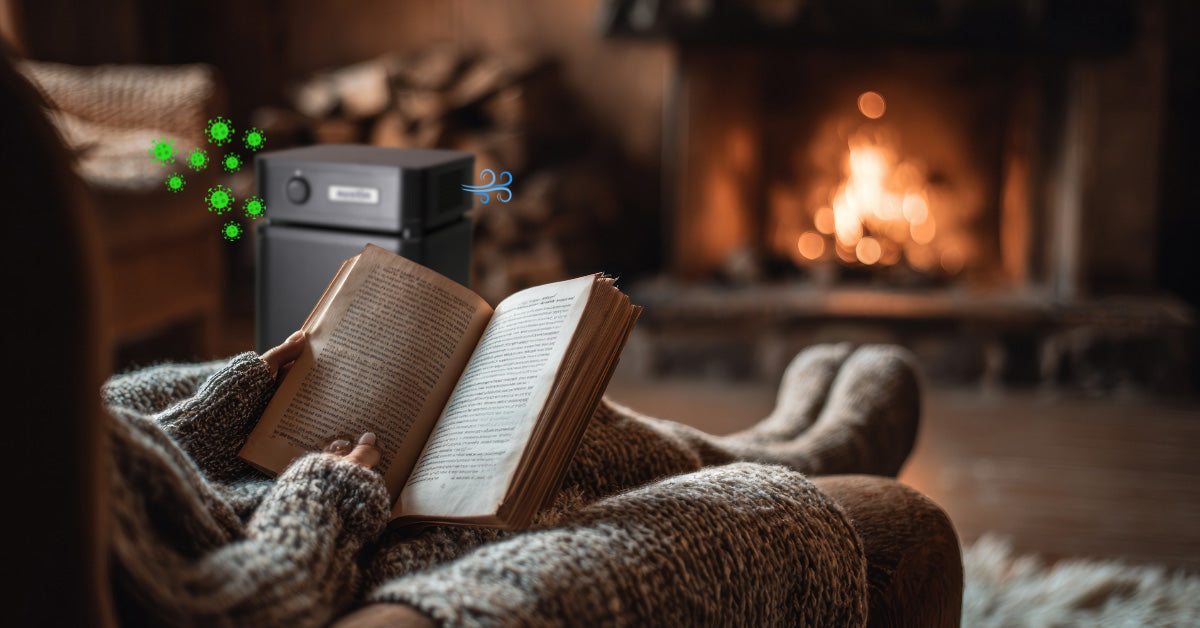It starts with a single sneeze in the classroom. Or the office. Or at home.
In a fraction of a second, that sneeze releases thousands of tiny droplets—a mix of water, mucus, and viral particles—into the air. Larger droplets fall quickly, but the smaller ones, called aerosols, can remain suspended for minutes or even hours. Some are smaller than 5 micrometers—so light they can travel across the room and hang in shared air long after the person has stopped coughing.
Each aerosol droplet can contain hundreds of viral particles. If the room is poorly ventilated, these particles accumulate, sneeze by sneeze and cough by cough. One cough becomes ten. Ten coughs become thousands of floating aerosols. Soon, the viral load in the air—the total amount of virus in a given volume—rises to levels that dramatically increase your risk of infection.
This chain reaction is exactly what researchers observed in a 2022 study by the University of Oregon.1 Their findings showed that ventilation, air filtration, and humidity were the most effective factors in reducing airborne viral persistence. In dry, stagnant air, viruses survived longer and spread more efficiently—but in well-ventilated, moderately humid environments that were filtered, the viral load dropped quickly.
Cold and flu season is a yearly challenge—but this year, you can approach it with a clearer understanding of what really affects your risk. In this article, we’ll explain two powerful concepts—viral load and body burden—and how they work together to influence whether you get sick and how severe your symptoms may be. You’ll also learn practical ways to reduce both.
Viral Load: From the Air to the Body
Once inhaled, those infectious aerosols enter the upper respiratory tract, where viral particles attach to mucosal cells. Each infected cell can release thousands of new viral copies, rapidly multiplying the viral load inside the body.
A 2021 study on COVID-19 explained this cascade clearly: higher viral load exposure in indoor air translates to higher infection probability—and often more severe symptoms.2 The immune system has to work harder and faster to contain the spread before it overwhelms the body.
That’s why two people in the same environment can have completely different outcomes. One might fend off infection entirely, while another may develop a full-blown illness. Part of this comes down to how much virus each person inhaled—but another critical factor is what’s already happening inside the body.
The Hidden Weight: Understanding Body Burden
Every person carries a unique body burden—the total accumulation of pollutants, chemicals, heavy metals, mold byproducts, and biological stressors that the body must process and eliminate.
When your body burden is low, the immune system has energy and resources to fight off new threats. But when it’s high—from chronic exposure to pollutants, allergens, or toxins—the immune system becomes overworked and less effective at defending against viruses.
A landmark study published in the journal, Reproductive Toxicology, found that certain, everyday toxins can directly suppress immune cell production, impair antibody formation, and reduce resistance to infection. This includes cigarette smoke, metals (like lead and arsenic), pesticides, and ubiquitous chemicals like dioxins, polycyclic aromatic hydrocarbons (PAHs), and polychlorinated biphenyls (PCBs).
Additional obstacles to immune resilience include oxidative stress and nutrient depletion.
This isn’t just theory. Below are some all-too-common examples of exposure that would increase body burden, putting the immune system on high alert before cold and flu season even begins:
-
Someone living in a home with mold exposure is already inhaling fungal spores that trigger chronic inflammation.
-
A person who recently moved into a new house might be surrounded by off-gassing volatile organic compounds (VOCs) from new furniture, flooring, and paint.
-
Anyone in a rural area where wildfire smoke, pesticide residues, or animal dander are prevalent
Once a respiratory virus enters the picture, the already burdened immune system can’t mount the same level of defense.

How to Break the Cycle
During cold and flu season, protecting yourself isn’t just about taking vitamin C or washing hands (though those help). The connection between air quality and immune resilience is clear: reducing exposure to pollutants and viral particles lightens both the viral load in the air and the body burden on your system.
Start with air purifiers that use Certified HEPA Material and activated carbon, like Austin Air Purifiers. High-efficiency Certified HEPA Material filters capture particles as small as 0.1 micrometers—tiny enough to trap airborne viruses, bacteria, and fine particulate matter (PM2.5). Activated carbon filtration removes harmful gases and chemical vapors, including VOCs and pesticides, which often linger long after cleaning or renovation. By lowering these environmental stressors, air purification helps the immune system redirect energy toward protection and recovery instead of detoxification.
But air purification works best as part of a broader indoor air strategy that includes ventilation and humidity control:
-
Ventilation: Bring in fresh air whenever possible. Opening windows for even a few minutes a day (when outdoor air quality allows) helps dilute indoor pollutants and reduce viral buildup. For homes and offices with limited airflow, mechanical ventilation systems or fans that promote air exchange can make a big difference.
-
Humidity Control: Maintain indoor humidity between 40–60%. Research shows that viruses survive longer in dry air, while overly damp conditions can encourage mold growth. A well-balanced humidity range helps minimize both risks—protecting respiratory tissues and reducing airborne viral persistence.
The Environmental Protection Agency highlights a striking example: indoor pesticide exposure.3 Pesticides can remain airborne for weeks, adding to toxic burden and respiratory irritation. Combining strong filtration with adequate ventilation and proper humidity levels can significantly reduce these pollutants—keeping the air cleaner, the immune system stronger, and your home healthier overall.

Breathing Easier This Season
Air purification isn’t just about comfort—it’s about resilience. By lowering viral load in the air and easing the body’s toxic burden, you help create conditions where your immune system can perform at its best.
Every breath of clean air is one less stressor for your body—and one more step toward staying healthy all season long.
REFERENCES
1 Parhizkar H, Dietz L, Olsen-Martinez A, et al. (2022 July 1). Quantifying Environmental Mitigation of Aerosol Viral Load in a Controlled Chamber With Participants Diagnosed With Coronavirus Disease 2019. Clinical Infectious Diseases. 75(1):174–184. doi: 10.1093/cid/ciac006.
2 Kriegel M, Hartmann A, Buchholz U, et al. (2021 Dec 25). SARS-CoV-2 Aerosol Transmission Indoors: A Closer Look at Viral Load, Infectivity, the Effectiveness of Preventive Measures and a Simple Approach for Practical Recommendations. Int J Environ Res Public Health. 19(1):220. doi: 10.3390/ijerph19010220.
3 Pesticides’ impact on indoor air quality. (2025, May 23). US Environmental Protection Agency. https://www.epa.gov/indoor-air-quality-iaq/pesticides-impact-indoor-air-quality.



